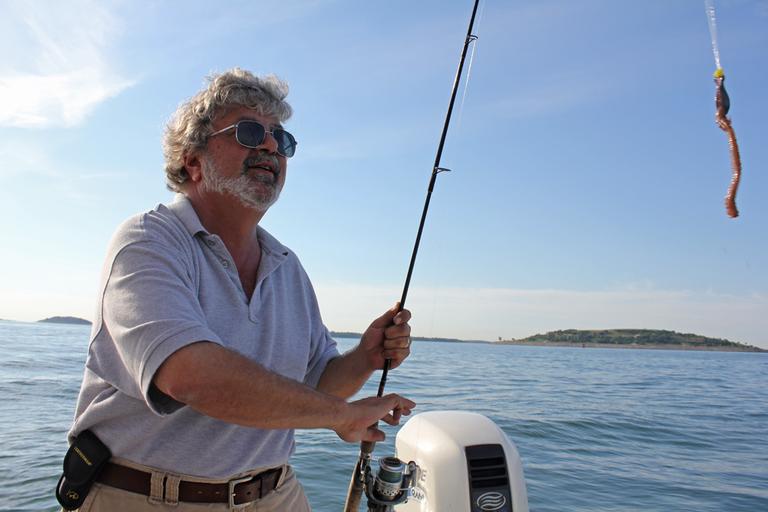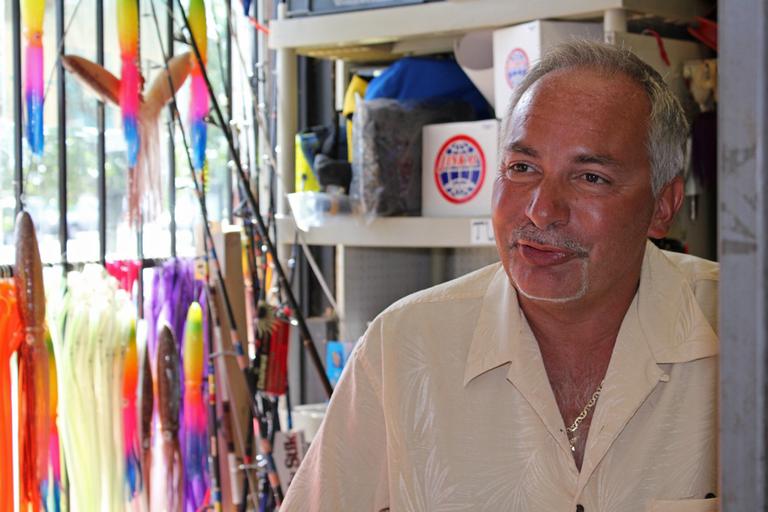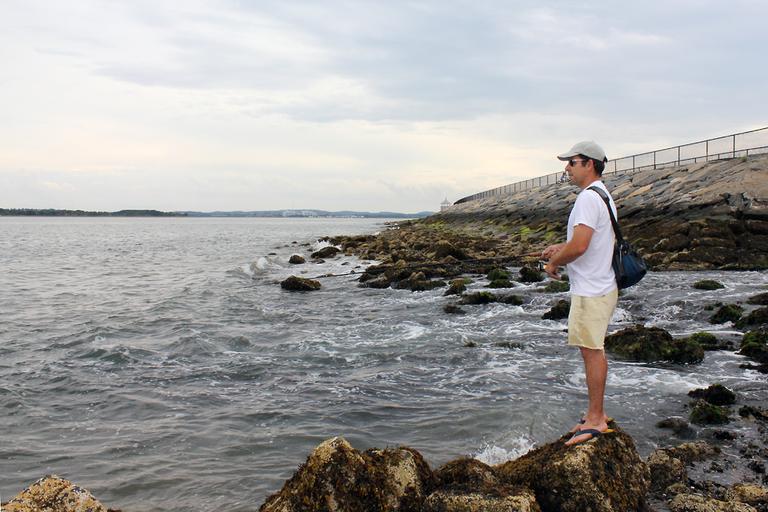Advertisement
Looking Out: Sport Fishing Is Alive In Boston Harbor
Resume
You may once have shuddered at the thought of fishing in Boston Harbor. But after a long clean-up effort, the waters are blue and the fish are healthy — and fishing for fun is coming back. This is the fifth installment in WBUR's summer series, "Looking Out: A New View of Boston Harbor."
Would you eat a fish you caught in Boston Harbor? Not long ago, you might not have been able to stomach the thought. But now ...
"The fish are beautiful," says Pete Santini, owner of Fish Finactics, a crowded little bait shop right off Route 99 in Everett. "The meat is nice, they're clean."
Santini is your man if you're looking to spend a day fishing on the harbor. He'll get you geared up and send you off with his latest intel. "I have hot information coming in all the time," he says, "It's like a network — this is the command center for fishing in Boston Harbor."
"It would smell. The water was brown. It was a nasty, nasty place to fish."
Pete Santini, owner, Fish Finatics
He's standing over a map of the harbor that he's taped on top of a freezer in his shop. "I'll bring out my chart," he says, "and I'll say, the stripers are hitting off of George's Island. I'll point over here, you'll fish the back side of George's Island at high tide, you'll throw tubes up on this high ground right here in about 10 feet of water."
Santini is an evangelist for fishing in Boston Harbor. He says there's world-class fishing to be done here and complains the city isn't doing enough to showcase that fact.
It certainly hasn't always been this way. Santini opened shop in 1993, as the government was ramping up its $4 billion harbor cleanup — building treatment plants to target the millions of gallons of Greater Boston's raw sewage flowing into the harbor every day.
"When the outfall pipe was right at Deer Island, all the stuff was bubbling up right there and it was nasty," Santini remembers. "It would smell. The water was brown. There'd be all kinds of foam and nastiness floating on top of the water. It was a nasty, nasty place to fish."
It's not that there weren't any fish. But who wants to eat something that was swimming around in that kind of water? "Sometimes you'd pull the flounders up, there were marks on the bottom of them, they'd be all scratched up," Santini says.
But now, in Santini's view, Boston Harbor is one of the best places in the country to fish for those flounders. Striped bass, too, and blue-fin tuna just outside the harbor.
No one is more proud of that transformation than Bruce Berman, founder and spokesman for Save The Harbor/Save The Bay, the advocacy group that has watched over the clean-up from the beginning.

Berman remembers when boats from New York and points south would hardly pause in Boston Harbor on their way to Maine.
"Now, every summer we have all these people coming in and staying for a week," he says. "Because it's one of the few places where you can catch striped bass in the morning, catch world-class baseball in the afternoon and catch a show in the evening. It's got everything."
We asked Berman to prove how good it's gotten by taking us fishing. Berman, an avid fisherman and a tireless harbor advocate, readily agreed. So on a recent sunny morning, we met him at Constitution Marina in Charlestown, where he spends most of the year living on a boat.
We don't take Berman's house out to sea. He has another boat for fishing: The Shamrock, a loud old thing. As we head out from the marina, Berman points to the dozens of new luxury hotels and condos that line the shore. He's always on the lookout for evidence of the harbor's growing popularity.
As we move through the harbor right off the U.S.S. Constitution, Berman points to the water. It looks nice — clear and blue.
"You can catch striped bass in the morning, world-class baseball in the afternoon and a show in the evening."
Bruce Berman, spokesman, Save The Harbor/Save The Bay
"As the sun comes up, it'll look bluer and bluer," Berman says. "Course, the water here is never going to look like it does in the tropics. We have older rivers. They have lots of leaves and tannin in them. And the harbor is always going to be stained a little bit. But the water quality is remarkable."
We head out for the expanse called Presidents Road, looking for birds — because where there are birds diving for small fish on the surface, there can be big fish underneath.
Berman throws out two lines, one for flounder and another for striped bass. And then we wait. And wait some more.
Finally a couple hours into our trip, there's a hit. We pull in a little flounder, only about 10 inches long, so we toss it back. But it's a beautiful fish — clean with a very white bottom. Nothing like those flounders that Santini was describing from years past.
We try a couple more spots, hoping to land a 30-inch striper like the ones Berman has been bragging about catching. But no such luck for us. Around noon, we call it a day and head back to the marina.
After an entire morning on the water, we only managed to catch one little flounder. So, we ask Berman, was all that money worth it? Was the clean-up worth $4 billion?
Berman doesn't hesitate. "Sure," he says. "Twenty years later, we're looking at a harbor that's a step away from being the cleanest urban harbor in the world. You're darn right it was worth it."
Because, for him, cleaning up the harbor is about more than bringing back the fish. It's about bringing back the people.
"If you'd asked me 20 years ago what I wanted to see on the harbor, I would have said, sure, clean water and economic development, but most of all, what I really wanted to see was people. Because the best way to keep the place clean is to integrate it into the life of the city," he says. "And that's happened."

On summer days, you can find people fishing from bridges and piers in Charlestown, Chelsea and Everett — and on beaches all over.
We found Andrew Mowbray on the rocky shore of Castle Island in South Boston on a recent afternoon. Mowbray, an artist, lives just a few minutes away in Dorchester and comes here to fish three or four times a week. He's been doing it ever since he moved to Boston about 10 years ago.
He calls the fishing great. On a good day, he'll catch as many as a dozen stripers. Today, he's been on the beach for about 20 minutes and already he's pulled in a keeper. But that's not really the point, he says.
"I come here by myself, but there’s a group of people that I just know over the years that are all different backgrounds and ethnicities — Brazilian, Spanish, Vietnamese, Chinese, Caucasian. It’s Boston down here. It’s a mix," Mowbray says. "That’s one thing that’s pretty great about fishing."
Mowbray is the future that harbor advocates like Bruce Berman were dreaming about 20 years ago. Mowbray has never known a dirty Boston Harbor, or worried about whether it's safe to eat the fish.
The water is just another part of the city he loves, another part of his life. The fish, they're a bonus.
More:
This program aired on July 22, 2010.